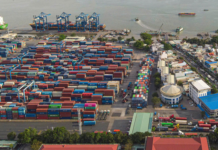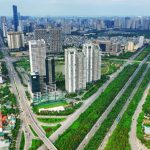
Nam Dinh City
Incorporating My Loc District into Nam Dinh City
Specifically, the entire natural area of 74.49 km2 and a population of 84,045 people from My Loc District will be incorporated into Nam Dinh City. Post-merger, Nam Dinh City will span an area of 120.90 km2 with a population of 364,181 people.
The establishment and reorganization of communal-level administrative units within Nam Dinh City are as follows:
Establishment of Nam Phong Ward: Based on the entire natural area of 6.58 km2 and a population of 9,160 people from Nam Phong Commune.
Establishment of Nam Van Ward: Based on the entire natural area of 5.62 km2 and a population of 7,637 people from Nam Van Commune.
Establishment of Hung Loc Ward: By merging the entire natural area of 5.25 km2 and a population of 8,071 people from My Hung Commune with the entire natural area of 4.72 km2 and a population of 5,886 people from My Loc Town. Post-merger, Hung Loc Ward will cover an area of 9.97 km2 with a population of 13,957 people.
Merger to form Tran Hung Dao Ward: By incorporating the entire natural area of 0.39 km2 and a population of 8,520 people from Phan Dinh Phung Ward and the entire natural area of 0.21 km2 and a population of 6,362 people from Nguyen Du Ward into Tran Hung Dao Ward. Post-merger, Tran Hung Dao Ward will span an area of 0.96 km2 with a population of 21,595 people.
Merger to form Cuu Bac Ward: By incorporating the entire natural area of 0.27 km2 and a population of 7,399 people from Ba Trieu Ward and the entire natural area of 0.46 km2 and a population of 9,286 people from Tran Dang Ninh Ward into Cuu Bac Ward. Post-merger, Cuu Bac Ward will cover an area of 1.37 km2 with a population of 31,323 people.
Merger to form Truong Thi Ward: By incorporating the entire natural area of 3.33 km2, a population of 7,674 people from Loc An Commune, and the entire natural area of 0.43 km2, a population of 11,967 people from Van Mieu Ward into Truong Thi Ward. Post-merger, Truong Thi Ward will span an area of 4.44 km2 with a population of 37,409 people.
Merger to form Quang Trung Ward: By incorporating the entire natural area of 0.59 km2 and a population of 20,391 people from Ha Long Ward and the entire natural area of 0.68 km2 and a population of 9,556 people from Thong Nhat Ward into Quang Trung Ward. Post-merger, Quang Trung Ward will cover an area of 1.57 km2 with a population of 41,215 people.
Merger to form Vi Xuyen Ward: By incorporating the entire natural area of 0.73 km2 and a population of 13,064 people from Tran Te Xuong Ward and the entire natural area of 0.64 km2 and a population of 7,638 people from Vi Hoang Ward into Vi Xuyen Ward. Post-merger, Vi Xuyen Ward will span an area of 1.89 km2 with a population of 31,254 people.
Merger to form Nang Tinh Ward: By incorporating the entire natural area of 0.36 km2 and a population of 5,477 people from Ngo Quyen Ward and an area of 0.91 km2 and a population of 12,702 people from Tran Quang Khai Ward into Nang Tinh Ward. Post-merger, Nang Tinh Ward will cover an area of 2.06 km2 with a population of 31,126 people.
Establishment of My Loc Commune: By merging the entire natural area of 5.79 km2 and a population of 4,985 people from My Thanh Commune, the entire natural area of 5.31 km2 and a population of 4,887 people from My Thinh Commune, and the entire natural area of 5.82 km2 and a population of 6,037 people from My Tien Commune. Post-merger, My Loc Commune will span an area of 16.92 km2 with a population of 15,909 people.
Following the reorganization, Nam Dinh City will comprise 21 communal-level administrative units (a reduction of 15 units), including 14 wards: Cuu Bac, Cuu Nam, Hung Loc, Loc Ha, Loc Hoa, Loc Vuong, Nam Phong, Nam Van, Nang Tinh, My Xa, Quang Trung, Tran Hung Dao, Truong Thi, and Vi Xuyen; and 7 communes: My Ha, My Loc, My Phuc, My Tan, My Thang, My Thuan, and My Trung.
Reorganization of communal-level administrative units within Nam Dinh Province is further elaborated in Resolution No. 1104/NQ-UBTVQH15 as follows:
Reorganization of communal-level administrative units within Vu Ban District
Merger to form Minh Tan Commune: By incorporating the entire natural area of 9.55 km2 and a population of 7,226 people from Tan Khanh Commune and the entire natural area of 9.34 km2 and a population of 10,566 people from Minh Thuan Commune into Minh Tan Commune. Post-merger, Minh Tan Commune will span an area of 25.84 km2 with a population of 23,257 people.
Merger to form Thanh Loi Commune: By incorporating the entire natural area of 4.27 km2 and a population of 5,385 people from Tan Thanh Commune and the entire natural area of 10.39 km2 and a population of 10,421 people from Lien Bao Commune into Thanh Loi Commune. Post-merger, Thanh Loi Commune will cover an area of 27.06 km2 with a population of 32,609 people.
Following the reorganization, Vu Ban District will comprise 14 communal-level administrative units, including 13 communes and 1 town (a reduction of 4 communes).
Reorganization of communal-level administrative units within Yi Yen District
Establishment of Trung Nghia Commune: By merging the entire natural area of 5.68 km2 and a population of 4,185 people from Yen Thanh Commune, the entire natural area of 5.08 km2 and a population of 5,445 people from Yen Nghia Commune, and the entire natural area of 9.99 km2 and a population of 7,017 people from Yen Trung Commune. Post-merger, Trung Nghia Commune will span an area of 20.75 km2 with a population of 16,647 people.
Establishment of Phu Hung Commune: By merging the entire natural area of 6.91 km2 and a population of 4,937 people from Yen Hung Commune, the entire natural area of 6.17 km2 and a population of 8,187 people from Yen Phu Commune, and the entire natural area of 6.11 km2 and a population of 6,725 people from Yen Phuong Commune. Post-merger, Phu Hung Commune will cover an area of 19.19 km2 with a population of 19,849 people.
Establishment of Tan Minh Commune: By merging the entire natural area of 7.44 km2 and a population of 4,961 people from Yen Minh Commune, the entire natural area of 8.14 km2 and a population of 7,026 people from Yen Loi Commune, and the entire natural area of 8.32 km2 and a population of 6,754 people from Yen Tan Commune. Post-merger, Tan Minh Commune will span an area of 23.90 km2 with a population of 18,741 people.
Establishment of Hong Quang Commune: By merging the entire natural area of 7.02 km2 and a population of 5,272 people from Yen Quang Commune, the entire natural area of 7.15 km2 and a population of 6,712 people from Yen Hong Commune, and the entire natural area of 10.75 km2 and a population of 10,519 people from Yen Bang Commune. Post-merger, Hong Quang Commune will cover an area of 24.92 km2 with a population of 22,503 people.
Following the reorganization, Yi Yen District will comprise 23 communal-level administrative units, including 22 communes and 1 town (a reduction of 8 communes).
Reorganization of communal-level administrative units within Nam Truc District
Establishment of Nam Dien Commune: By merging the entire natural area of 3.95 km2 and a population of 4,937 people from Nam Toan Commune, the entire natural area of 4.33 km2 and a population of 7,456 people from Nam My Commune, and the entire natural area of 10.41 km2 and a population of 14,347 people from Dien Xa Commune. Post-merger, Nam Dien Commune will span an area of 18.69 km2 with a population of 26,740 people.
Following the reorganization, Nam Truc District will comprise 18 communal-level administrative units, including 17 communes and 1 town (a reduction of 2 communes).
Reorganization of communal-level administrative units within Xuan Truong District
Establishment of Xuan Giang Commune: By merging the entire natural area of 5.27 km2 and a population of 8,461 people from Xuan Dai Commune, the entire natural area of 5.94 km2 and a population of 11,080 people from Xuan Phong Commune, and the entire natural area of 3.58 km2 and a population of 5,783 people from Xuan Thuy Commune. Post-merger, Xuan Giang Commune will cover an area of 14.79 km2 with a population of 25,324 people.
Establishment of Xuan Phuc Commune: By merging the entire natural area of 5.41 km2 and a population of 10,712 people from Xuan Hoa Commune, the entire natural area of 3.53 km2 and a population of 9,693 people from Xuan Kien Commune, and the entire natural area of 3.53 km2 and a population of 14,170 people from Xuan Tien Commune. Post-merger, Xuan Phuc Commune will span an area of 12.47 km2 with a population of 34,575 people.
Establishment of Tra Lu Commune: By merging the entire natural area of 3.18 km2 and a population of 8,843 people from Xuan Bac Commune, the entire natural area of 2.21 km2 and a population of 9,497 people from Xuan Trung Commune, and the entire natural area of 2.84 km2 and a population of 7,286 people from Xuan Phuong Commune. Post-merger, Tra Lu Commune will cover an area of 8.23 km2 with a population of 25,626 people.
Following the reorganization, Xuan Truong District will comprise 14 communal-level administrative units, including 13 communes and 1 town (a reduction of 6 communes).
Reorganization of communal-level administrative units within Nghia Hung District
Merger to form Quy Nhat Town: By incorporating the entire natural area of 8.15 km2 and a population of 5,306 people from Nghia Binh Commune and the entire natural area of 6.28 km2 and a population of 6,223 people from Nghia Tan Commune into Quy Nhat Town. Post-merger, Quy Nhat Town will span an area of 19.98 km2 with a population of 18,499 people.
Establishment of Dong Thinh Commune: By merging the entire natural area of 5.34 km2 and a population of 5,580 people from Nghia Minh Commune, the entire natural area of 6.03 km2 and a population of 7,350 people from Nghia Dong Commune, and the entire natural area of 8.63 km2 and a population of 8,456 people from Nghia Thinh Commune. Post-merger, Dong Thinh Commune will cover an area of 20.00 km2 with a population of 21,386 people.
Following the reorganization, Nghia Hung District will comprise 20 communal-level administrative units, including 17 communes and 3 towns (a reduction of 4 communes).
Reorganization of communal-level administrative units within Hai Hau District
Merger to form Yen Dinh Town: By incorporating the entire natural area of 4.08 km2 and a population of 7,765 people from Hai Bac Commune and the entire natural area of 4.97 km2 and a population of 8,505 people from Hai Phuong Commune into Yen Dinh Town. Post-merger, Yen Dinh Town will span an area of 10.82 km2 with a population of 23,244 people.
Merger to form Con Town: By incorporating the entire natural area of 3.47 km2 and a population of 6,279 people from Hai Chinh Commune and the entire natural area of
The Great Hanoi Restructure: Managing a Thousand Redundant Officials
The city of Hanoi is undergoing a significant transformation with the merger of wards and communes, resulting in an excess of over 1,000 staff, civil servants, and non-specialist personnel. To address this, Hanoi plans to redeploy over 400 individuals to new locations, while also offering early retirement packages, streamlining personnel, and terminating the contracts of more than 300 others.









































